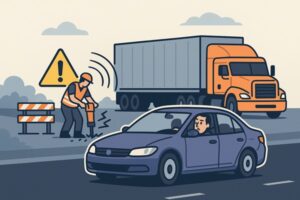We’ve all been there: driving along, minding our own business, when a sudden, jarring sound erupts nearby. Maybe it’s the screech of construction machinery or the thunderous blast of a semi-truck’s air brake. Whatever it is, that single moment of surprise can trigger panic, distraction, or even a crash. While we often think of loud noises as just annoying, a semi-truck accident attorney warns that they can actually pose serious risks on the road. When equipment near a roadway creates unpredictable or startling sounds, it can cause drivers to react in ways that compromise safety. Understanding how these noises impact nearby vehicles and how to reduce their effects could prevent countless accidents.
How Sudden Sounds Disrupt Driver Focus
Driving requires near-constant concentration. Every movement, checking mirrors, maintaining speed, staying within lanes, relies on a driver’s ability to remain calm and aware. Startling sounds break that concentration instantly.
Imagine cruising alongside a construction zone when a jackhammer fires up without warning. That sharp, percussive noise sends a jolt of adrenaline through your system. In that split second, your brain shifts from “drive safely” mode to “what was that?” mode. You might tap the brakes, swerve slightly, or take your eyes off the road to locate the sound.
Studies show that sudden noises can trigger involuntary reactions, such as muscle tensing or the startle reflex. On a busy highway, those small reflexes can have significant consequences—especially if you’re sharing the road with large trucks or other heavy equipment.
Construction Zones: A Symphony of Hazards
Construction zones are some of the noisiest environments on the road. Between backup alarms, drilling, saws, and metal clanging, it’s practically an orchestra of potential distractions.
While these sounds serve important safety purposes—like warning workers when equipment is reversing—they also create sensory overload for passing drivers. For example:
- Backup alarms on large machinery are designed to alert workers. Still, when multiple machines are operating, those beeps can blend, making it hard to tell where the danger is coming from.
- Air-powered tools like nail guns or pneumatic drills release sharp bursts that can startle even experienced drivers.
- Heavy equipment movement—the thud of excavators or the rumble of dump trucks—creates vibration and low-frequency noise that can distort a driver’s perception of distance and space.
Drivers already navigating narrow lanes or reduced-speed zones can easily become overwhelmed. A single startled reaction could lead to rear-end collisions, sideswipes, or worse.
The Unique Threat Around Semi-Trucks
Semi-trucks bring their own set of auditory challenges. The loud release of air brakes, sudden gear shifts, or the deep rumble of diesel engines can all catch nearby drivers off guard.
One hazardous situation occurs when a trucker suddenly engages the engine brake (Jake brake) on a downhill slope. The sound—a rapid series of explosions within the engine—can be deafening up close. For a driver in the next lane, that can sound like a malfunction or even a crash. The natural reaction might be to brake suddenly or veer away from the noise, increasing the risk of a multi-vehicle accident.
Truck drivers themselves aren’t immune either. Startling sounds from nearby vehicles or work zones can cause them to overreact, leading to abrupt lane changes or braking that endangers everyone around them.
What Can Be Done to Reduce the Risk
Reducing noise-related hazards doesn’t mean silencing essential safety alerts—it’s about more innovative sound management. Here’s how:
- Improved sound design: Some manufacturers are now developing backup alarms that adjust their volume based on ambient noise levels, making them audible without being overly loud.
- Better communication at worksites: Posting clear signage about ongoing construction and noise hazards gives drivers time to prepare mentally.
- Public awareness: Educating drivers about standard equipment sounds can help reduce panic reactions when they encounter them.
For truckers and equipment operators, using quieter, well-maintained machinery and following local noise ordinances can also go a long way in preventing dangerous distractions.
When the Unexpected Leads to the Unthinkable
Despite precautions, not every incident can be avoided. A loud sound might cause one driver to slam on the brakes, another to swerve, and before anyone realizes it, a serious accident occurs.
These moments often unfold in seconds but can leave lasting consequences. Victims of such crashes may face medical bills, time away from work, and emotional trauma—all from something as simple as a startling noise.
If you’ve been involved in a crash triggered by loud or unexpected equipment sounds—especially one involving a commercial vehicle—it’s crucial to understand your rights. Consulting a semi-truck accident attorney can help you uncover what really caused the crash and pursue the compensation you deserve.
Conclusion: Awareness Is the First Line of Defense
Startling equipment sounds may seem like a minor inconvenience, but on today’s crowded roads, they can be the spark that ignites a chain reaction of danger. From construction sites to highway hauls, unexpected noises test every driver’s reflexes and patience. By staying alert, anticipating noisy zones, and understanding how these sounds influence behavior, we can all take steps to reduce risk. And if the worst happens, remember—help is available. A skilled lawyer can guide you through the aftermath, ensuring that a moment of shock doesn’t lead to a lifetime of hardship.
